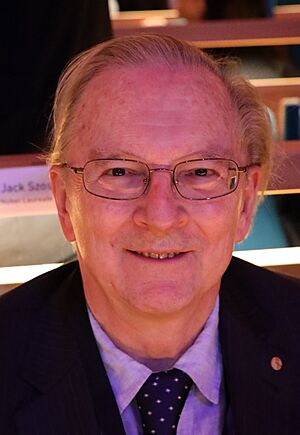Jack W. Szostak facts for kids
Quick facts for kids
Jack Szostak
|
|
|---|---|

Szostak at the 2024 Nobel Prize lectures
|
|
| Born |
Jack William Szostak
November 9, 1952 London, England
|
| Education | McGill University (BSc) Cornell University (PhD) |
| Awards |
|
| Scientific career | |
| Fields | Biochemistry Genetics Synthetic biology Bioengineering |
| Institutions | University of Chicago (2022) Harvard Medical School Howard Hughes Medical Institute |
| Thesis | Specific binding of a synthetic oligonucleotide to the yeast iso-1 cytochrome c̲ mRNA and gene (1977) |
| Doctoral advisor | Ray Wu |
| Notable students | David Bartel Jennifer Doudna Hiroaki Suga Neha Kamat Terry Orr-Weaver |
Jack William Szostak is a Canadian-American biologist and a Nobel Prize winner. He is a professor at the University of Chicago and used to teach at Harvard Medical School.
Szostak has done very important work in genetics, which is the study of how traits are passed down through families. His discoveries helped scientists understand where genes are located in animals and how to work with them. This work was also key to the Human Genome Project, which mapped all human genes. In 2009, he won the Nobel Prize for Physiology or Medicine. He shared this award with Elizabeth Blackburn and Carol W. Greider for finding out how telomeres protect chromosomes.
Contents
Early Life and Education
Jack Szostak grew up in Montreal and Ottawa, Canada. He finished Riverdale High School (Quebec) at age 15 with a special scholars prize.
He then earned a Bachelor of Science (B.Sc) degree in cell biology from McGill University when he was 19. During his college years in 1970, he joined a summer program at The Jackson Laboratory. There, he worked with Dr. Chen K. Chai.
Szostak later earned his PhD in biochemistry from Cornell University. After that, he started his own research lab at the Sidney Farber Cancer Institute, which is part of Harvard Medical School. In 1984, he moved to Massachusetts General Hospital. He became a full professor at Harvard Medical School in 1988. In 2022, he joined the University of Chicago as a professor in the Department of Chemistry.
Research and Discoveries
Jack Szostak has made many important discoveries in genetics. He is known for creating the world's first yeast artificial chromosome. This was a big step that helped scientists find the location of genes in mammals. It also helped them create ways to change or "manipulate" genes. His work was very important for the Human Genome Project, which aimed to map all the genes in humans.
His research also helped explain how chromosomal recombination happens. This is when genes get mixed up during meiosis, a type of cell division. He also helped us understand how telomeres work. Telomeres are special DNA parts at the ends of chromosomes that protect them.
In the early 1990s, Szostak's lab started studying RNA enzymes. These are special RNA molecules that can act like enzymes. He developed a method called in vitro evolution of RNA. This method allows scientists to find RNA molecules with specific jobs by repeating cycles of selection and change. He was the first to find an aptamer, which is a molecule that can bind to a specific target.
Understanding the Origin of Life
Currently, Szostak's lab is focused on understanding how life began on Earth. They are also trying to build artificial cells in the lab. They have studied how RNA templates might have copied themselves on early Earth, before enzymes existed.
They have looked at special molecules called phosphorimidazolides. These molecules might have helped new RNA strands grow. Szostak's group found that these molecules help RNA grow faster. This discovery supports ideas first suggested by Leslie Orgel about how life might have started.
Szostak and Katarzyna Adamala also found a way to solve two problems at once. They showed that a weak acid like citric acid can protect RNA from damage by magnesium ions. It can also keep the fatty acid membranes of early cells from breaking apart.
Beyond his lab work, Szostak has given talks about the origin of life. For example, he spoke at the first Starmus Festival in 2011. He later joined the festival's board of directors.
Awards and Honors
Jack Szostak has received many awards for his important work. He is a member of several important scientific groups, including the National Academy of Sciences.
Some of his major awards include:
- The United States National Academy of Sciences Award in Molecular Biology
- The 2006 Lasker Award for Basic Medical Research
- The 2009 Nobel Prize for Physiology or Medicine (shared with Elizabeth Blackburn and Carol W. Greider)
- The 2011 Oparin Medal
The Alfred Nobel Foundation explained his Nobel Prize win: "An organism's genes are stored within DNA molecules, which are found in chromosomes inside its cells' nuclei. When a cell divides, it is important that its chromosomes are copied in full, and that they are not damaged. At each end of a chromosome lies a 'cap' or telomere, as it is known, which protects it. After Elizabeth Blackburn discovered that telomeres have a particular DNA, through experiments conducted on ciliates and yeast, she and Jack Szostak proved in 1982 that the telomeres' DNA prevents chromosomes from being broken down."
Personal Life
Jack Szostak is married to Terri-Lynn McCormick. They have two sons. He also has two sisters, Carolyn Szostak and Kathy Hysen.
See also
 In Spanish: Jack Szostak para niños
In Spanish: Jack Szostak para niños
- Functional information

